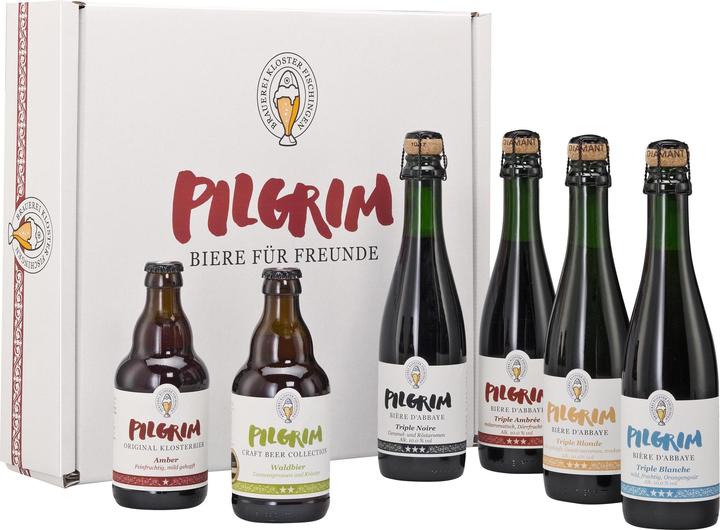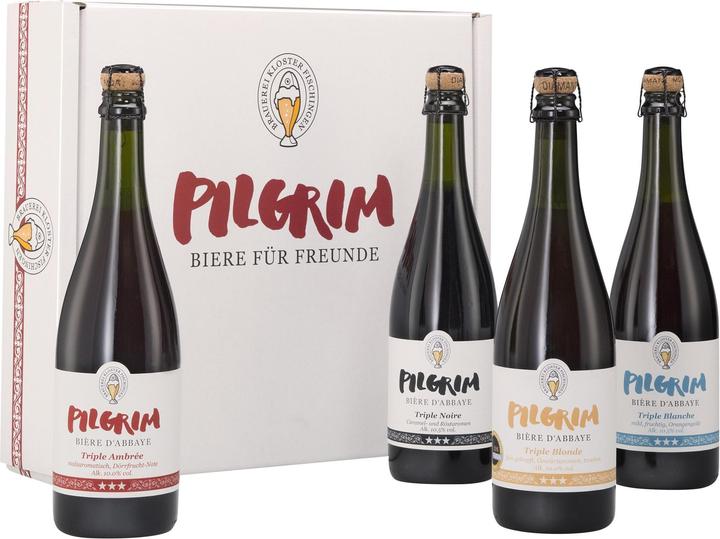

Visit to the "Pilgrim" brewery: a pilgrimage for the senses
In a picturesque Benedictine monastery in Fischingen, Thurgau, very special beers are brewed that have nothing in common with the regular lager of our ancestors. We visited the birthplace of "Pilgrim" barley juice and were spoilt not only in terms of taste but also spiritually.
The magnificent Benedictine monastery in Fischingen was founded in 1138 by Bishop Ulrich II of Constance as a pilgrimage centre. It is located on the world-famous Way of St James - 2300 kilometres from Santiago de Compostela in Spain. Fortunately, we didn't have to travel that far to enjoy the "Pilgrim" beer, which takes its name from its prominent location. Nevertheless, the pilgrimage to Fischingen was an adventure for everyone: the two authors were guided by their satnavs through the seemingly endless labyrinth of 30 km/h zones in the city of Zurich and along forest and meadow paths. Our photographer Christian only just made it to the pilgrimage site due to a train cancellation. The car of host and "Pilgrim" founder Martin Wartmann refused to leave: "Key not recognised". With a slight delay and the second key, it worked after all.
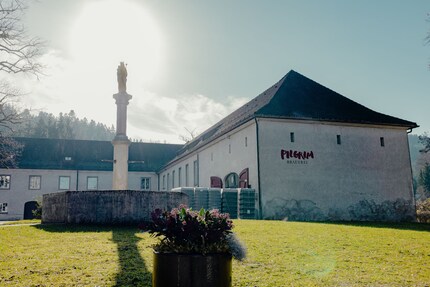
Source: Christian Walker
The effort was worth it: the baroque Fischingen Monastery is located in an enchanting landscape, surrounded by deep green, wooded hills. The sparse clouds in the sky finally give way to the sun. Spring-like temperatures make us forget that it is still the middle of winter. We fortify ourselves with a mildly fruity, amber-coloured "Pilgrim Kloster Amber" and are welcomed by a friendly host: Even the 76-year-old Martin Wartmann seems spring-like rejuvenated - he sparkles with energy, charm, knowledge and exciting stories.
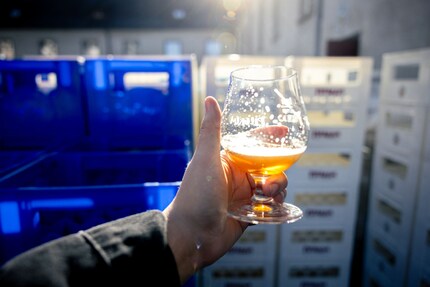
Source: Christian Walker
Find your niche
Martin Wartmann is the heart and soul of "Pilgrim". He lives and breathes beer brewing. He started out as an accountant at a young age at the Müller brewery in Aargau. He and his superiors soon realised that counting peas was not enough to keep him busy, so why not learn the brewing trade from scratch? This is where he earned his spurs, having to keep meticulous records of work steps and materials at Dr Müller's ... right down to the bristles of brushes.
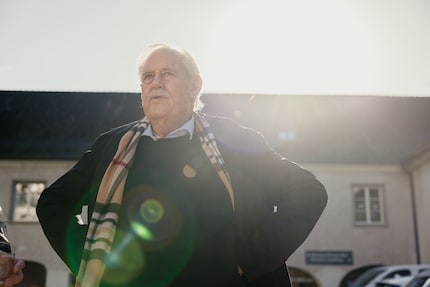
Source: Christian Walker
After training as a master brewer at the Research and Teaching Institute for Brewing at the Technical University of Berlin, he was soon able to deepen his knowledge at the Actienbrauerei Frauenfeld. His vision was always to move away from the cartel beer "Lager hell" and brew other beers. In addition to "Weizentrumpf", the first Swiss wheat beer, he developed "Klosterbräu", the first real Swiss craft beer, for the nearby Ittingen Charterhouse. Martin Wartmann already knew one thing as a youngster: standard lagers were a lost cause for microbrewers in Switzerland. He had to find his niche. However, the Swiss beer cartel left very little room for manoeuvre for microbrewers.
"The Godfather" sends its regards
The brewery giants of the time, Hürlimann, Feldschlösschen and Cardinal, as well as other members of the Swiss Beer Brewers' Association, determined the Swiss beer market from 1935 to 1991: sales territories and customers were allocated, prices defined, advertising formats and labelling prescribed ... and probably the greatest outrage from the point of view of every beer lover: beer types and quality were strictly defined. Barley malt, hops, yeast and water; light lager, dark lager, speciality beer and festival beer - nothing more was allowed ... It brings back memories of "The Godfather".
Martin Wartmann elegantly circumnavigated this cartel iceberg. Inspired by the Belgian Trappist monks, he invented a new style of beer in 1982 with "Ittinger Klosterbräu", the first Swiss amber beer that was not part of the cartel range. The flavour was characterised by 5.6% by volume, several types of malt, some of which were intensely roasted, and aromatic hops. Despite the poor forecasts of the major cartel brewers, this niche developed so well that the beer giant Heineken became aware of the flavourful "Ittinger Klosterbräu" and integrated it into its range. Wartmann later sold the brand and the recipe to Heineken. He went on to explore new playgrounds at Brauhaus Sternen in Frauenfeld, where he brewed "Wartmann's No. 1", the first high-end beer in Switzerland.

Source: Christian Walker
Martin Wartmann retains this revolutionary attitude to this day. He regularly attends craft beer congresses in the USA, where he also met the legendary Samuel Adams mastermind Jim Koch from the Boston Beer Company. His motto: "Don't brew your beer for yourself, make beers for your friends". This credo - beers for friends - has inspired Martin Wartmann and has not let go: instead of resting on his laurels, he founded the "Pilgrim" brewery in Fischingen Monastery in 2014 together with two other investors.
How the flavour gets into the beer
Martin Wartmann can realise his vision at Fischingen Monastery: "Brewing high-end and gourmet beers according to old, traditional recipes with the knowledge and technology of today". He is still tinkering with new recipes. The basic ingredients are the same as for every beer: water, malt, hops and yeast. Plus a few mysterious spices and fruits from the Belgian brewing tradition.

Source: Christian Walker
The water comes from the monastery's own spring, but is softened for beer production. Soft water produces finer beers. In addition, the monastery water has a little too
much magnesium. Although this is healthy, sensitive people occasionally have an allergic reaction to it.
Martin Wartmann makes no compromises when it comes to malt: A brewer must understand the malting trade; it is the same profession, he says. Malt is germinated grain. It not only gives the beer its basic character, it also makes fermentation possible in the first place - the sugar from the malt starch is converted into alcohol. For Martin Wartmann, Swiss malt is a marketing gimmick and has little to do with quality. He prefers to import the right malts for the respective
style of beer from all the major malt-growing regions and thus achieves the desired flavour profile. The master brewer has a dozen malts at his disposal. We were allowed to touch, smell and taste different malts. Pale malts taste wonderfully mild and sweet, while the roasted dark malts have a sweet-bitter, slightly smoky flavour. They are reminiscent of coffee beans.
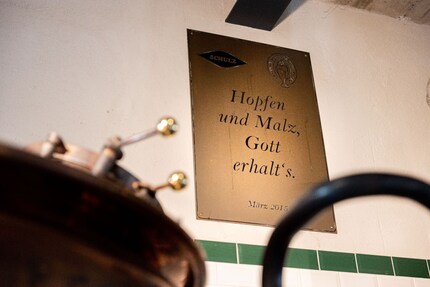
Source: Christian Walker
The hops provide the bitterness in the beer and flavour it. Here, too, Martin Wartmann searches the world for the optimum varieties for the respective beer style. In an English ale, for example, Fuggles hops are a must, while Cascade hops give an American IPA its lemony flavour. A good brewer, like a top chef, must know his ingredients and their effects precisely.
The "Pilgrim" beers are flavoured with forest herbs and spices, depending on the style. For example, Martin Wartmann reveals with a wink that his better version of the pale lager - the warm-fermented "Pilgrim Blond Ale" - contains a special spice: only very little, but it has a big effect. Even a Bavarian brewmaster friend of his admitted this. And that's saying something: Because the purity law is upheld in Bavaria. Spices have no place in beer there.
And the shark ...
"Pilgrim" is fermented in open or closed tanks. Open fermentation is an absolute must for high-proof premium beers. Here, several yeast strains are allowed to feast on the malt sugar and convert it into alcohol. For Martin Wartmann, the yeasts are essential and are the true secret of brewing: "Yeasts have a decisive influence on the flavour. That's why "Pilgrim" looks after its yeasts, skims them, washes them and reuses them.
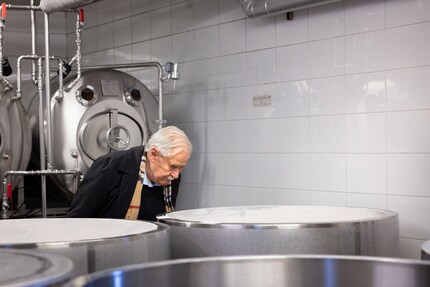
Source: Christian Walker
In open fermentation, up to three different yeasts are used: the first provides a lot of flavour and produces a lower alcohol content. The second increases the alcohol content and refines the beer with additional flavours. The third raises the volume percentage further, but does little for the palate: Martin Wartmann affectionately calls it the "shark" - it often eats the other yeasts too.
After fermentation, the "Pilgrim" is transferred to cans, bottles or barrels, depending on the type of beer. The Grand Crus beers continue to mature for months in oak barrels in the monks' old monastery cellar, where they develop their flavours. Depending on the previous barrel ageing, these are whisky, tequila, wine or calvados flavours. Even barrels in which maple syrup was previously stored are used. And soon a series of barrels will be delivered in which whiskey and then chilli sauce matured. It will be interesting to see ...
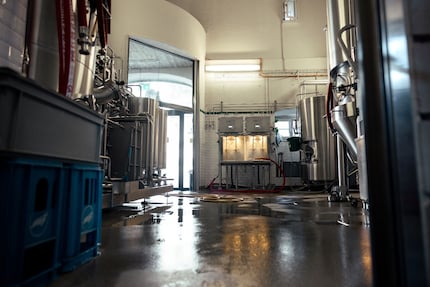
Source: Christian Walker
The Pilgrim and the Falcon
An experienced team, meticulous brewing skills, varied and fine beers ... Pilgrim should be buzzing. The brewery has to sell 300,000 bottles to break even. Pilgrim almost achieved this shortly before the coronavirus crisis. But then the pandemic and the war in Ukraine threw a spanner in the works for the monastery brewery: raw material prices rose and sales fell. In 2023, "only" around 250,000 bottles were sold. This resulted in a considerable loss.
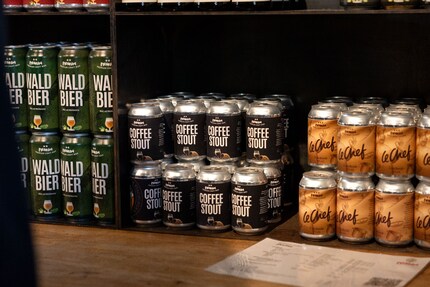
Source: Christian Walker
But Martin Wartmann is not giving up, he believes in his beer vision. The more rationalised bottling of Pilgrim's entry-level beer line in larger cans - made possible thanks to a cooperation with the Schaffhausen-based brewery Falken - means that production costs can be reduced. Falken now brews the "Blond Ale" and the "Waldbier" and includes both in its own range. The "Pilgrim" in the 50 cl cans is therefore competitively priced with the barley juice from the large breweries. According to Martin Wartmann, no compromises are made in terms of flavour, although my colleague Dani Frey, an avowed "Pilgrim" fan, thinks that the "Waldbier" no longer tastes the same. But Martin Wartmann waves it away: the reason for variations in flavour is that the herbs don't always have exactly the same effect. The current batch has a little more flavour from the spruce shoots. We are curious. That's also what makes a small brewery: The beer doesn't always taste the same, so it never gets boring.
Zen in the monastery cellar
We were able to find out that "Pilgrim" beers are anything but boring in the time-honoured beer cellar. It smells of malt, wooden barrels and wet stone. And it was there that Martin Wartmann spoilt us with a tasting. In addition to the "Blond Ale", the programme included beer gems such as the Abbey beer "Triple Blonde" and barrel-aged treasures such as the "Vintage Beer", the "Limited Edition No. 6 Maple Syrup" and the "Limited Edition No. 5 Calvados". Martin Wartmann tells us that when tasting these fine beers, you first need to practise a little and prepare your palate with a light beer such as the "Blond Ale". Only then can the heavier calibres be tasted.
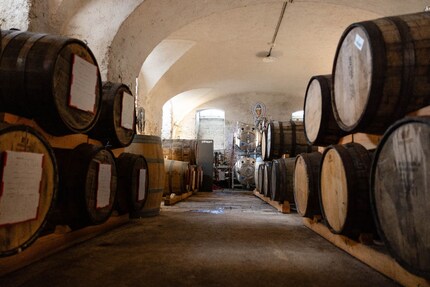
Source: Christian Walker
Martin Wartmann regularly does Zen meditations. This is the "Direttissima to yourself", he explains. The idea is not to hold on to thoughts, but to let them pass by and not judge them. Meditation is also recommended for "Pilgrim" tasting: look at the colour of the beer, smell it, let it roll slowly over your tongue and palate, take in the flavours - without judging. In this way, you will experience the true diversity of beer and realise that the golden barley juice is not just boring lager ... a door opens into a huge, wide world of flavours. With its many different beer styles, "Pilgrim" is the perfect way to discover this world and your favourite type of beer.
Finally, we ask Martin Wartmann what new beer trends he has discovered on his recent trips to the US. Fruit beers are currently going through the roof there. These are also in the pipeline at "Pilgrim". For beer lovers and those who want to become one, things have never been more exciting in Switzerland.
Wermutwolf.ch is a young online magazine dedicated to drinking culture, with a focus on Swiss creations. The Wolf occasionally writes for us on the topics of beer, wine and various other tipples.
Interesting facts about products, behind-the-scenes looks at manufacturers and deep-dives on interesting people.
Show all